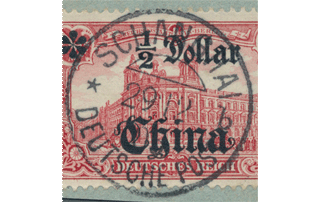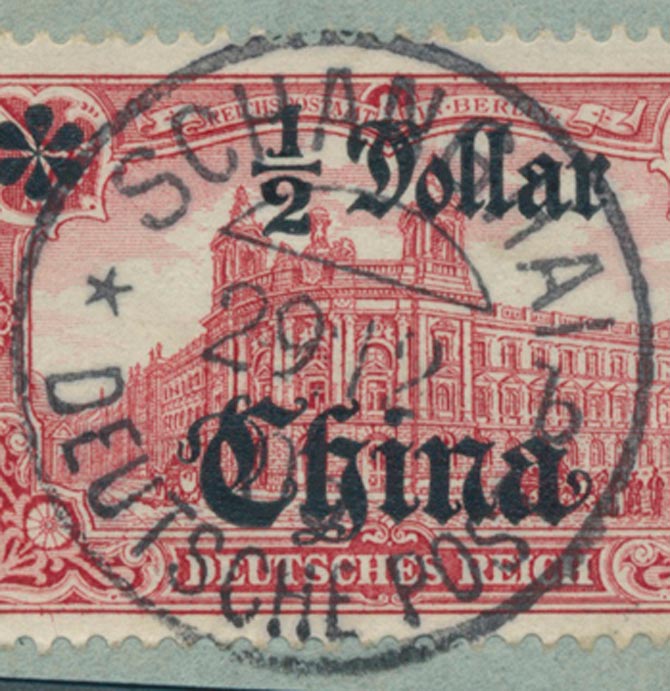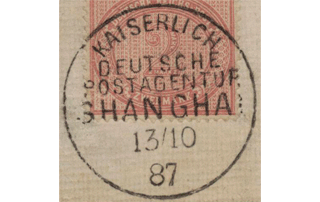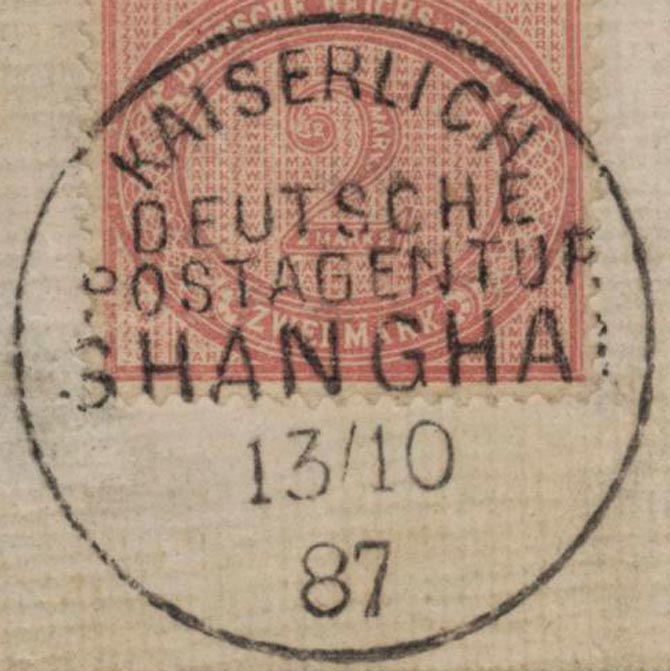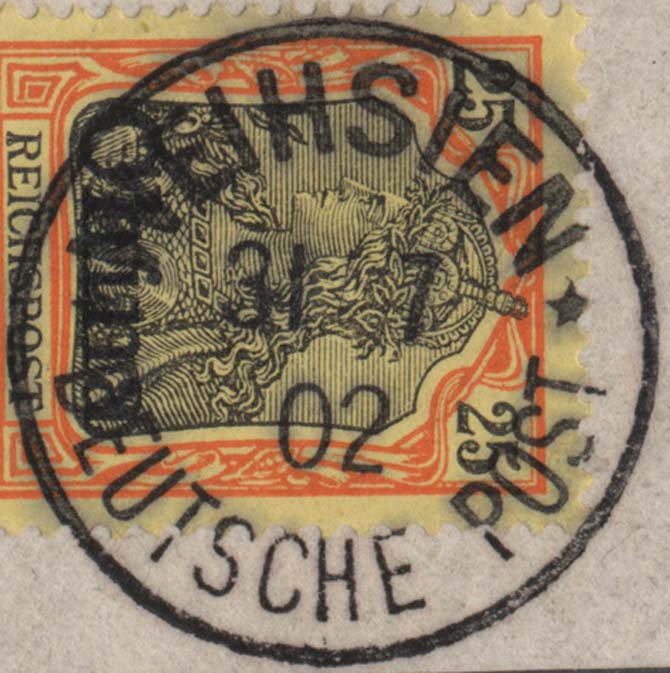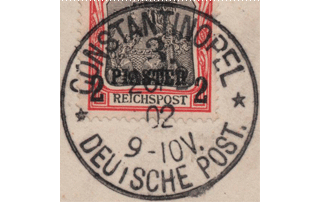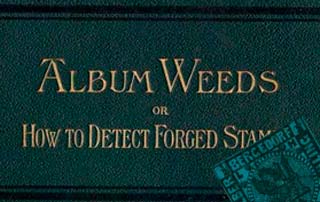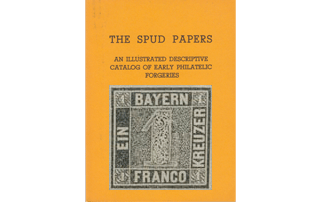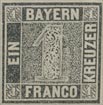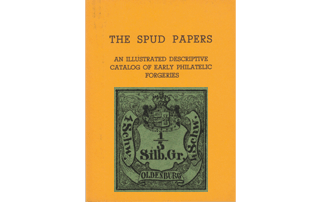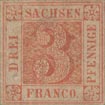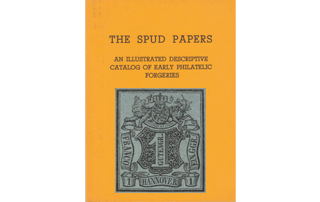The matrices of all the five values were engraved on one stone, and were reproduced by lithography. In the i schilling, the numerals in the corners vary, as the lithographer obliterated them in his transfer, and put in smaller ones by hand. The matrix of the 1 1/2 Sch. had the value in the plural (“Schillinge”). As strict grammarians objected to this, the lithographer altered it to “schilling” in his transfers. Hence the reprints, taken by transfer from the matrix, have “Schillinge.” Mr. Westoby’s Stamps of Europe, to which I am indebted for all the above information, states that a few unused originals are known, made at Bergedorf, with “Schillinge,” and so, from this, it is evident that the lithographer did not make the alteration until after some impressions had been taken by way of trial. And indeed this might have been expected, for the stamps would evidently have to be made before they could be objected to. We may therefore consider the “Schillinge” (original) to be simply a proof, or, as some people call it, an essay.
1861, November 1st. 1/2 Schilling, black on violet; 3 Schilling, black on rose.
These stamps have always been very rare; and this is not to be wondered at, when we consider the extremely short life which they enjoyed. They are said to have been suppressed on the 10th of the same month, making way for the 1/2 Schilling, black on blue, and the 3 Schilling, blue on rose. But though the originals are so rare, the reprints are more common; and I fancy that they have often been passed off on the unsuspecting as real originals. However, col- lectors need not be taken in by them, if they will remember that the originals are very nicely done, and all the design is very clear; whereas these reprints show signs of wear in the matrix. Besides this, the originals are in soft colours, whilst the reprints are on paper which is too highly coloured, and they look altogether too new.
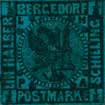 1/2 Schilling, black on violet.
1/2 Schilling, black on violet.
Genuine
Lithographed, in greyish-black, on rather dull, violet wove paper. Surrounding the central design there is a circle of little rings, all linked together, and all very regular; these rings are 55 in
number. Both in this and all the other values of both issues the central design is formed by “climidiation”, as the heralds call it, of half the triple-turreted castle of Lübeck, joined to half of
Hamburg; showing, I suppose, that Bergedorf was under the joint protection of these two places. The left-hand turret is very slightly lower than the right-hand one. The half of a tail which the heralds have left to the unfortunate eagle is almost entirely of solid colour; but the shading, when it can be made out, is composed of two wavy, or rather curved, vertical lines, strongly bent towards the left, in the center. The eight shaded balls in the spandrels, outside the linked rings, all touch both the rings and the outer frame; though, in lightly-printed copies, the ball near the E of HALBER does not touch the center frame, and the one near the N of SCHILLING does not touch the linked rings. The horizontal black lines on the body of the castle (representing the courses of brickwork) divide it into ten coloured horizontal strips (I have counted the spaces, instead of the black lines, as there is less likelihood of making a mistake). The left-hand turret on the castle shows ten similar horizontal coloured spaces above the battlements, with parts of two others at the bottom; and the right-hand tower has nine spaces, with parts of two others at the bottom. The tail of each R of BERGEDORF is suddenly pinched off to a sort of point. The tail of the K of POSTMARKE is joined to the center of the oblique stroke. The fractions in the corners are composed of very fat figures; each little
1 being nearly as fat or thick as the upright stroke of the B of BERGEDORF. The I in the left top corner is not set in the center of the containing-square, but far too much to the right; and the little 1 of the fraction in the right top corner is not set above the 2, but far too much to the right, and the whole fraction is somewhat to the right of the center of the containing-square. The upper half of the shield on the breast of the eagle shows parts of four thin, broken vertical lines; and the lower half shows four thick, vertical lines, not counting the vertical outline of the castle. The eagle’s beak is very strongly hooked. There is a curly line of the background, which joins the point of the beak, and curves inwards, towards the lower part of the neck; and, in the space thus enclosed, under the chin, there are two other curly or wavy lines—a long and a short one. The topmost ring, under the second E of BERGEDORF, has a small black dot in the center. The ring of the post-horn is darkly shaded all over with vertical lines. The lines of the background are extremely wavy.
First Forgery
Nicely lithographed, in jet-black, on paper of a very cold violet. There are 55 linked rings, as in the genuine; but they are irregular, and some of them hardly overlap their neighbours at all. The left-hand turret is decidedly lower than the other. The eagle’s tail shows three thick, perfectly straight, vertical lines of shading, the right-hand one being the outline of the castle. The ball immediately to the left of the c of SCHILLING does not touch the rings. There are only seven coloured, horizontal bands across the body of the castle. The turrets both show seven similar, horizontal bands. Each R of BERGEDORF has its tail cut off perfectly square. The tail of the K of POSTMARKE joins the oblique stroke rather high up, but not so far as the center of the said stroke. The fractions are in thin figures, each 1 being much thinner than the upright stroke of the B of BERGEDORF. The I in the left top corner is set very slightly to the right of the center of the containing-square ; the one in the right top corner is in the center of the square, and the 1 is almost centrally over the 2, though not quite. The upper half of the shield on the breast of the eagle shows three rather coarse, vertical lines: and the lower half also has three vertical lines, the middle one being not quite parallel with the other two. The eagle’s beak is very slightly hooked: and the wavy line of shading, proceeding from near the base of the neck, does not go near the point of the beak. There is no dot in the top ring. The post-horn has very little shading on it.
Second Forgery
Lithographed, in jet-black, on almost neutral-tinted wove paper. There are only 46 linked rings (instead of 55) round the central circle, and they are irregular. I think it will not be necessary to give any further test, as the rings are easy to count.
Postmarks
Genuine.—98. Occasionally it is struck twice, the second time at a different angle, making the whole into a zigzag. The distance between any two of the bars is 3 1/2 mm.
First Forgery.—98. Same distance apart as the genuine.
Second Forgery.—98. Lines very thin, and 3 3/4 mm. apart.
3 Schilling, black on claret-red.
Genuine
Lithographed, in greyish-black, on rose, or rather pale claret-red paper. There are, as usual, 55 linked rings, encircling the central design. is a black dot in the ring on the right side, opposite
the head of the second L of SCHILLING. The lower half of the B, in the word BERGEDORF, is a good deal larger than the upper one. This may be very easily seen by turning the stamp upside down. The tail of the first R in this word is thickest in the middle, and gets narrower towards each extremity. The last R in the same word has the tail smallest at the point of insertion, and widest (square) at the outer end; and the D is rather tall and narrow, but it is plainly a D, and nothing else. The post-horn has a very large and badly-shaped mouthpiece; but the tube is very much smaller, or rather thinner, than the mouthpiece, till it begins to turn round. The 3 in the left top corner goes very close to the upper outline of the containing-square; but the others evidently do not touch any of their respective containing-squares. The lower half of the shield contains four distinct, straight, vertical lines, not counting the vertical outline of the castle; and the other half shows the commencements of three thin, vertical lines.
First Forgery
Lithographed, in jet-black, on violet wove paper. There are only 50 linked rings round the central circle.
Second Forgery
Lithographed, in jet-black, on pale red wove paper. There are only 51 linked rings.
Third Forgery
Lithographed, on pale red wove paper, very like the colour of the genuine. There are only 52 linked rings.
Fourth Forgery
Lithographed, in jet-black, on very hard, very pale, almost buff paper. There are only 54 linked rings. The eagle’s head, in this forgery, is much more like that of a donkey than of a bird 1
Fifth Forgery
This is an extremely poor production. It is lithographed, in jet-black, on yellowish, or pale buff wove paper. My specimen has been painted Prussian blue, all over the face, by hand. There are only 42 linked rings.
Postmarks
Genuine.—98.
First Forgery.—98. Space between bars 3 3/4 mm
Second Forgery.—Ditto.
Third Forgery.—Ditto. Nearly 4 mm. space between bars.
Fourth Forgery.—Ditto. Thick bars; spaced 3 1/4 mm. apart.
Fifth Forgery.—Ditto, but there are only three bars, and they are 4 mm. apart.
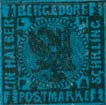 1861, November 10th. 1/2 Schilling’, black on blue.
1861, November 10th. 1/2 Schilling’, black on blue.
Genuine
Lithographed, in rather dull black, on somewhat pale, Prussian-blue wove paper. The tests are the same as for the 1/2 schilling of the first issue.
First Forgery
Lithographed, in intense black, on very dark blue paper, though still of a Prussian-blue tint. This forgery is dangerous, for there are 55 linked rings, as in the genuine; but they are uneven, some of the rings being larger than the rest. There is no dot in the top ring. The left- hand turret is much lower than the right-hand one. The eagle’s tail shows three perfectly straight, vertical lines of shading. The ball to the left of the C of SCHILLING does not touch the rings. There are 7 horizontal blue bars across the body of the castle, 8 across the left-hand turret, and 7 across the right-hand one. Each R of BERGEDORF has its tail widest at the end, and cut off almost square. The tail of the K of POSTMARKE joins the bottom of the oblique stroke, instead of its center. The fractions are in the centers of the containing-squares, and the figures of the said fractions are too thin. The upper half of the shield on the breast of the eagle shows three very short, thick, vertical lines; and the lower half has three thick and long vertical lines. The eagle’s beak is not hooked; it looks something like the lips of a camel. There is a clear line of shading, running between the beak and the nearest part of the wing, which is not in the genuine. There is no dot in the top ring. The post-horn has very little shading on it. The curly lines of the background, especially to the right of the castle, are far straighter than the genuine.
Second Forgery
This is by Engelhardt Fohl, of Leipzig. Lithographed, in dull, greasy black, on dull Prussian-blue wove paper, showing an extremely coarse grain, when held up to the light. There are only 47 linked rings.
Third Forgery
Lithographed, in jet black, on dark blue wove paper. There are only 45 rings, and they are very irregular.
Fourth Forgery
Lithographed, on pale, greenish-blue wove paper. There are only 45 rings. The two rings over R of POSTMARKE are linked; the rest only touch each other, instead of being linked.
Postmarks
Genuine.—98. As before.
First Forgery.—98. Very thick bars, 4 mm. apart. I have also seen three bars, in red, only 1 1/4 mm. apart.
Second Forgery.—I have never seen this cancelled.
Third Forgery.—Uncancelled.
Fourth Forgery.—Uncancelled.
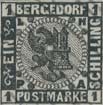 1 Schilling, black on white.
1 Schilling, black on white.
Genuine
Lithographed, in very dull black, on yellowish-white wove paper. There are 55 linked rings, as before; and there is a black dot in the top ring, under the second E of BERGEDORF; another in
the ring at the middle of the right side, opposite the head of the first L of SCHILLING, and a third on the left side, opposite the 1 of EIN. The tail of the eagle is the same as in the genuine 1/2 schilling. The ball below ER of BERGEDORF hardly touches the rings, and the one to the left of the N of SCHILLING does not touch the rings, and hardly touches the frame; but all the other balls touch both frame and rings. There are eight white bars across the body of the castle, the first and last being very thin and ragged. The turrets each show eight white bars, from the battlements of the castle to the beginning of their roofs, but they are not very distinct. Each R of BERGEDORF is the same as in the genuine i schilling. The lower half of the shield on the breast of the eagle bears four thick, vertical lines, as in the i schilling. The eagle’s beak is strongly hooked; and there is one line of the background between the point of the beak and the nearest part of the wing; the beak touches this line. The post-horn is the same as in the genuine 1/2 schilling.
First Forgery
Nicely lithographed, in jet black, on greyish-white wove paper. There are 55 linked rings, as in the genuine, but the three dots in the rings are absent. The tail of the eagle shows five almost straight, vertical lines All the eight balls touch both rings and frame, except the one under OR of BERGEDORF, which touches neither, and the one to the left of the N of SCHILLING, which does not touch the rings. The white lines across the body of the castle are the same as in the genuine; as are also those on the turrets, though the latter are much more difficult to make out than they are in the genuine. The lower half of the shield on the breast of the eagle shows five vertical lines, but the outer ones are very often
blotched into the outlines of the shield. The eagle’s beak almost touches the wing; and there is no line to be seen between the points of the beak and the nearest part of the wing. The ring under the beginning of the D of BERGEDORF is very badly shaped; indeed, all the rings on the right side of the circle are not nearly so regular as those on the left side.
Second Forgery
This is Fohl’s. Poorly lithographed, in smudgy, greyish-black, on very greyish-white wove paper. There are only 51 linked rings, and they are irregular.
Third Forgery
Rather well lithographed, on grey wove paper. There are 55 linked rings, as in the genuine, but no dots in the rings. The tail of the eagle is shaded by thin, straight, vertical lines. The ball below ER of BERGEDORF does not touch the rings; the one opposite the N of SCHILLING does not touch either rings or frame ; all the others touch both rings and frame. There are eight white lines across the body of the castle; the top one is very thin, but the others are rather better than the genuine. The postmark covers the upper part of the shield on the eagle’s breast in my specimen, but there do not seem to be any lines on it. The lower half of the shield shows four thick, vertical lines, not counting the outline of the castle. The eagle’s beak is like a parrot’s, and wide open. The postmark covers the space between the beak and the wing; but I can see that there is no line running from the point of the beak to the base of the neck, and all the lines of the background are very faint. The T and M of POSTMARKE have their tops joined together, though they are a good distance apart in the genuine. This is not a bad-looking forgery.
Fourth Forgery
Lithographed, in deep black, on stout, yellowish-white wove paper. There are only 47 linked rings, and they are irregular on the right side.
Fifth Forgery
Lithographed, on greyish-white wove paper. There are only 50 rings, and the outlines of some of them are strangely thickened, near the HILL of SCHILLING, the RGE of BERGEDORF, and the EL of EIN.
Sixth Forgery
Lithographed, in deep black, on yellowish-white wove paper, rather soft. There are only 49 rings; they are very irregular, and most of them only touch each other, instead of being linked. The lettering of BERGEDORF and POSTMARKE is absurdly thin.
Postmarks
Genuine.—As before.
First Forgery.—Generally uncancelled, but also to be found with 98; the bars are thick, and 35 mm. apart.
Second Forgery.—Uncancelled.
Third Forgery.—98. There are five thick bars, only 1 1/2 mm. apart.
Fourth Forgery.—Uncancelled.
Fifth Forgery.—Uncancelled.
Sixth Forgery.—Uncancelled.
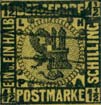 1 1/2 Schilling, black on yellow.
1 1/2 Schilling, black on yellow.
Genuine
Lithographed, on pale yellow wove paper. There are 55 linked, rings, as before, with a black dot in the topmost ring, just under the second E of BERGEDORF, as in the I schilling, and another in the ring to the left of the first L of SCHILLING. The right-hand turret has a very distinct ball on the top of it. The eagle’s tail is the same as in the genuine 1/2 schilling. The eye is large and round, and is placed most absurdly far down. All the balls touch both rings and frame. There are eight yellow horizontal bands across the body of the castle, between the base and the battlements, the top one being very thin. They are not so plain as in the genuine 1/2 and 1 schilling, as there are several thin black lines between the regular courses of brickwork, thus confusing them. The left turret shows eight yellow bars, and the right turret nine. None of the figures of the fractions in the corners touch any part of their respective containing-squares; though the fraction-line of the 1 1/2 in the right top corner, and the similar line in the left bottom corner, both touch the right side of the square. The lower half of the shield shows five thick, vertical lines. The eagle’s beak does not touch the wing; and there is no line of shading touching the very point of the beak. The serif to the head of the little 1 of the left bottom 1/2 is double, i.e., there are two projections to the left of the head of the figure, instead of one. The wide end of the post-horn does not touch the base of the castle above it. The ring of the post-horn is lightly shaded, with short lines, just crossing the tube; and, if they were prolonged, they would all meet in the center of the ring of the horn.
First Forgery
This is poor. Lithographed, in jet-black, on orange-yellow wove paper. There are only 48 rings in the circle, and they merely touch each other, instead of being linked together. There are no dots in the rings. The word SCHILLING is replaced by POSTMARKE, i.e., there is POSTMARK E both at the left side, and at the bottom as well.
Second Forgery
Lithographed, in deep black, on pale yellow wove paper. There are 55 rings, as in the genuine. The eagle’s tail has two perfectly straight vertical lines in it, not counting the outline of the gate of the castle. The eye is small, of 110 particular shape, and placed in a normal position. The ball to the left of the C of SCHILLING does not touch the rings. There are eight distinct, thick lines across the body of the castle, with no thin lines to confuse them. There are about seven lines across each of the turrets, but my single specimen is blotched by the postmark just there, so that I cannot be certain as to the exact number. The tops of the large and small 1, and the tail of the small 2 in the 1 1/2 in the left top corner, all touch the outline of the containing-square; and the fraction-line of the 1 1/2 in the right top corner does not touch the outline of the square. The lower half of the shield bears four vertical lines, as in the genuine; but they are not all exactly parallel with each other. The stop after the small U of EIN U. EIN HALB, which is large and distinct in the genuine, is barely visible in this forgery. The eagle’s beak touches the wing. There is a very tiny dot in the ring to the left of the 1, and another in the one to the left of the first L, and another in the one to the left of the second L of SCHILLING, besides one in the ring under the O of BERGEDORF, which touches the black ball; but whether these four dots are accidental or not I cannot say. The topmost ring has no dot in it.
Third Forgery
Lithographed, in jet-black, on dull yellow wove paper. There are only 43 rings, and some of them are twice the size of others.
Fourth Forgery
Lithographed, in jet-black, on bright yellow wove paper. There are only 46 rings. They are fairly regular.
Fifth Forgery
Lithographed, in jet-black, on stout, hard, bright orange-yellow wove paper. There are only 43 rings. They are fairly regular.
Postmarks
Genuine.—As before.
First Forgery.—Uncancelled.
Second Forgery.—98. The bars are thick, and 3 1/4 mm. apart.
Third Forgery.—Uncancelled, or a blotch of writing-ink.
Fourth Forgery.—Uncancelled.
Fifth Forgery.—Uncancelled.
 1 1/2 “Schillinge”, black on yellow.
1 1/2 “Schillinge”, black on yellow.
Genuine
I have already spoken of the status of this stamp. It is lithographed, on the same paper as the 1 1/2 Schilling, and the design is exactly the same, except for the addition of the final E to SCHILLING.
First Forgery
This is Fohl’s production. Lithographed, in dull black, on orange-yellow wove paper. There are 55 rings, as in the genuine, but no dots in the rings. The eagle’s tail is solid, or nearly so. The stamp is always heavily printed, so that most of the balls are solid, instead of showing shading-lines. The courses of brickwork across the castle cannot be made out with any certainty; and it is the same with the turrets; indeed, the left-hand turret is practically solid. The serif of the large 1 of the 1 Jr in the left top corner touches the outline to left of it, though it does not do so in the genuine. The fraction-line in the left lower corner does not touch the right outline of the square. The lower half of the shield is solid black. The serif to the head of the little 1 of the fraction in the left lower corner is single, instead of double. The wide end of the post-horn touches the base of the castle. The ring of the post-horn is shaded almost solid. There is a tiny black dot, outside the stamp, above the G of BERGEDORF. The lettering of all the inscriptions is very thin and ragged; and there is no cross-bar to the H or the A of HALBER, and only a mutilated one to the A of POSTMARKE.
Second Forgery
Lithographed, in jet-black, on stout, bright orange-yellow wove paper. There are only 43 rings.
Postmarks
Genuine.—Being only a trial stamp, or essay, genuinely used specimens are unknown.
First Forgery.—Uncancelled.
Second Forgery.—Uncancelled.
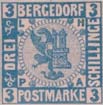 3 Schillinge, blue on rose.
3 Schillinge, blue on rose.
Genuine
Lithographed, in a sort of chalky, ultramarine blue, on pale pink or rose paper. The tests are the same as for the 3 schilling of the first issue.
First Forgery
Lithographed, in brilliant, dark ultramarine, on very shiny, rose-coloured wove paper. There are only 50 linked rings. This is not the same type as the first forgery of the 3 Schillinge, of the first issue.
Second Forgery
This is Fohl’s. Lithographed, in bright ultramarine, on rather dark rose wove paper. There are only 52 linked rings.
Third Forgery
This seems to be the commonest of all. Lithographed, in rather pale Prussian-blue, on very pale pink wove paper, thick and hard. There are only 54 linked rings.
Fourth Forgery
Nicely lithographed, in deep blue, on very dark rose (almost magenta) wove paper, thick and hard. There are only 43 linked rings ; but otherwise the stamp looks very nice.
Fifth Forgery
Poorly lithographed, in dull ultramarine, on very thick, very hard, dull rose paper. There are only 47 rings ; and they merely touch each other, instead of being linked together. I think this is the poorest of the forgeries of this value.
Sixth Forgery
Lithographed, in dull blue, on very pale rose wove paper. It has 50 rings, like the first forgery, but may be distinguished from it, by having the numerals very thin, and by the fact that the wide end of the post- horn touches the base of the castle. It is a poor-looking counterfeit.
Seventh Forgery
Lithographed, in pale ultramarine, on pale rose wove paper. There are only 45 rings. The balls are very lightly shaded with vertical lines, and are hardly visible at a first glance.
Postmarks
Genuine.—As before.
First Forgery.—98. The bars are 3 1/4 mm. apart.
Second Forgery.—Uncancelled.
Third Forgery.—98. I have this with thin bars, 9 mm. apart (!), and with thicker bars, 3 1/2 mm. apart.
Fourth Forgery.—Uncancelled.
Fifth Forgery.—Uncancelled.
Sixth Forgery.—98. The bars are thin, and nearly 3 1/2 mm. apart.
Seventh Forgery.—Uncancelled.
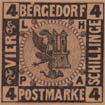 4 Schillinge, black on brown.
4 Schillinge, black on brown.
Genuine
Lithographed, the best executed of the set, in dull black, on wove paper of a sort of dirty Indian-red, or Sienna-red colour, which the catalogues generally agree to denominate “brown.” There are 55 linked rings, as before. There is a very tiny dot in the ring on the left side, near the bases of the IE of VIER. This dot is not in the center of the ring, but close to the left-hand edge of it. In the ring on the right side of the stamp, between the tops of the LL of SCHILLING, there is another tiny dot, not in the
center of the ring, but at its extreme right-hand edge. These dots could certainly not be seen, unless specially looked for, with the microscope. The eagle’s tail is the same as in the genuine 1/2 Schilling. All the balls touch both frame and rings. The upper half of the shield on the breast of the eagle shows parts of four thin, vertical lines ; and the lower half shows four thick ones. The beak is nearly closed, and has a sort of Roman-nosed outline. The eye is a small, distinct outlined circle, not shaded. The spiral part of the post-horn is shaded with vertical lines. Eleven feathers in the wing are tolerably easy to see, and the tip of the wing touches the junction between two rings. The end of the tail hangs down very distinctly, a good distance below the base of the castle. The figures in the corners are exactly alike, except that the left-hand point of the 4 in the left top corner is a little sharper than the points of the others. The middle v-part of the M of POSTMARKE is sharply pointed. The foot of the eagle shows two claws, pointing to the left side of the stamp, one directly downwards, and the fourth obliquely down towards the post-horn. The tail of each R of BERGEDORF is, as it were, pinched off to a point, which is directed obliquely downwards to the right.
First Forgery
Lithographed, in jet-black, on pale buff wove paper. There are only 53 linked rings.
Second Forgery
This is Fohl’s. Lithographed, in dull black, on wove paper, very similar to that of the genuine in colour. There are 55 linked rings, as in the genuine, but without the dots. They are fairly regular. The eagle’s tail is a black mass of solid colour. The upper half of the shield is perfectly blank, and the lower half is almost solid black. The eagle has a head like a greyhound, with a rather blunt nose; and there is no eye to be seen. The shading on the spiral part of the post-horn follows the outline, instead of being vertical. No more than eight feathers, large and small, can be made out, in the wing of the eagle; and the tip of it touches almost the middle of a ring instead of the junction between two rings. The end of the tail is very little lower than the base-line of the castle. All the figures differ slightly, either in shape or position: the point of the one in the left top corner goes too near to the left outline of the containing-square; that in the right top corner has its point too blunt and drooping; that in the left bottom corner has its oblique outline somewhat curved, instead of straight; and that in the right bottom corner has its transverse tail longer than the tails of the other three. The large end of the post-horn comes very close to the base of the castle. The middle v-part of the M of POSTMARKE is cut off square, instead of being pointed. Two of the claws of the eagle point to the left, as in the genuine; but both the others point downwards. The tail of the first R of BERGEDORF is like the genuine; while the tail of the second R is cut off square.
Third Forgery
Lithographed, in jet-black, on pinkish-grey wove paper, which looks a sort of lilac at a distance. There are 55 rings, as in the genuine, but without the dots, and they are not very regular, some of them not over-lapping so far as the others. The eagle’s tail, in my specimen, is a solid mass of colour. The ball below the H in the right upper spandrel is at some distance from the rings; and the ball above the A, in the right lower spandrel, does not actually touch the rings, though it is very near. The upper half of the shield shows one transverse line, with (generally) a v-shaped mark standing on the transverse line; the lower half of the shield is nearly solid, but four thick vertical lines can usually be made out, by the aid of the microscope. The upper mandible of the beak is very little curved, and it is not like the beak of an eagle at all. The eye seems to have a crescent-shaped line of shading across it. The spiral part of the post-horn is shaded with irregular dots. There seem to be only six feathers in the wing, but my specimen is partly covered by the postmark just there, so there may be more than six, but certainly not more than about eight. The foot of the eagle is very indistinct in my specimen; but, as far as I can make out, one claw points upwards, one obliquely down to the left, one to the right, and one directly downwards. The tip of the wing does not touch the rings.
Fourth Forgery
This counterfeit is no longer in my possession, so I reproduce the description from the second edition. Lithographed, in intense black, on almost salmon-coloured wove paper. There are 55 linked rings, as in the genuine. The ball under the H in the right-hand top spandrel does not touch the rings, the ball above the A in the right-hand bottom spandrel does not touch the rings, and the ball above the L in the left-hand top spandrel does not touch the rings. All the lettering of the stamp is very long and thin, not half as broad as in the genuine. All the lines of the background, on the right of the castle, are almost straight, and very wide apart. The tip of the eagle’s wing does not touch the rings. The tube of the post-horn is far too thick, and is almost the same thickness all the way, except just at the “bell” end. Between the wing and neck of the eagle there are four almost straight lines of background. The E of the word SCHILLINGE is at a considerable distance from the side of the frame.
Fifth Forgery
Lithographed, in jet-black, on pale salmon-coloured wove paper. There are only 42 rings, irregularly linked, and without dots.
Sixth Forgery
This is a frightful thing, and would hardly deceive the veriest tyro. Very coarsely lithographed, in dull black, on very thick, dull buff wove paper. The rings are represented by 42 white pearls, on a black, circular band. I have seldom seen a worse counterfeit of any stamp.
Seventh Forgery
Rather nicely lithographed, in jet-black, on stout, dark brown wove paper, very nearly the colour of the old Brunswick 1/4 Sgr. There are only 39 rings.
In all these forgeries of the 4 Schillinge, No. 2 is the only one in which the colour of the paper comes anything near that of the genuine stamps; and even this said No. 2 is far too red, being almost exactly the colour of the second reprint.
Postmarks
Genuine.—As before.
First Forgery.—Uncancelled.
Second Forgery.—Uncancelled.
Third Forgery.—98. The bars are rather more than 3 1/4 mm. apart.
Fourth Forgery.—98. Five thick bars, a little over 3 mm. apart.
Fifth Forgery.—Uncancelled.
Sixth Forgery.—Uncancelled.
Seventh Forgery.—Uncancelled.
From: ‘Album Weeds’, 3rd edition by R. B. Eareé. 1906

